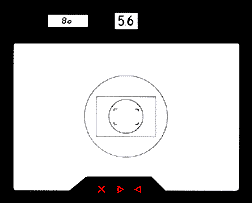 |
|
The Nikon F3AF is essentially an electronic SLR camera and will require battery to power all its major camera operations (There is a mechanical backup lever supplied should battery fail to function in extreme temperature or be depleted). Thus, you have to install a battery(ies) into the camera before using the camera.
 |
2. Load batteries into the clip. |
Caution: As a precautionary measure, Keep batteries away from infants and small children. In case a battery is accidentally swallowed, call a doctor immediately as the material inside the batteries can cause serious problems. |
 |
3. Reattach the battery clip. |
 |
|
5. Load the batteries
into the finder's battery chamber.
 |
|
 |
|
 |
7. Move the power switch to uncover the red dot. |
 |
|
9. Check battery
power.
Look through the viewfinder. Without a lens mounted on the camera body, the focus-impossible
warning (red X-shaped LED) blinks or lights up continuously, while the liquid crystal
display (LCD) shows the shutter speed. These displays indicate that the batteries
have been properly installed and their power is adequate.
|
|
|
Note : If a lens is mounted on the camera, either the red X or one or both the focus indicators (two red LED arrows) will light up.
10. Mount the lens
onto the camera.
First, make sure that the meter coupling lever is locked in the "down"
position. Grasp the lens by its lens barrel. Then, line up the aperture index on
the lens with the lens mounting index on the camera body and twist the lens counterclockwise
until it clicks into place. Confirm that the aperture index is right on top.
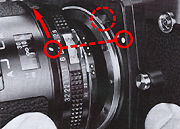 |
|
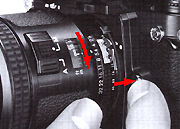 |
|
11. Open the camera
back.
While pushing the camera back lock level counterclockwise with your thumb, lift the
film rewind knob and the camera back will pop open.
 |
|
12. Install the
film cartridge.
Drop the film cartridge into the film cartridge chamber so that the film leader
points toward the take-up spool , and push the rewind knob back down into place.
 |
|
13. Insert the film
leader in the take-up spool.
Pull the leader across the camera and insert it into one of the slots in the
film take-up spool.
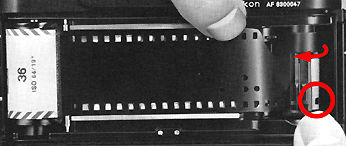 |
|
 |
|
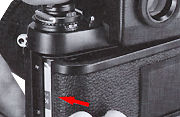 |
|
 |
|
17. Make blank exposures until the frame counter reaches frame one.
To dispose of the first few frames exposed during film loading, continue to alternately advance the film and depress the shutter release button until the counter reaches frame one (the first dot past 0).
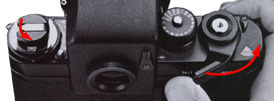 |
|
Notes : 1)
When making blank exposures, set the shutter speed dial to A or to 1/125 sec. or
above, and the shutter will be released at 1/80 sec. with 80 or M 80 displayed by
the LCD in the viewfinder.
2) Do not take pictures prior to the first frame, as the meter does not function
until the counter reaches one.
|
| | | Back to Index of Nikon F3 Models Back to Pictorial History of Nikon SLRs |
|
|||||
|
|||||||
| Back to Main Index Page of Nikon F3 Site |
| About this photographic site | Contributions and Credits |
 |
Home - Photography in Malaysia |
